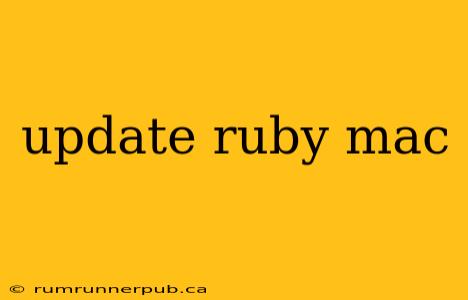Keeping your Ruby installation up-to-date is crucial for accessing the latest features, security patches, and performance improvements. This article will guide you through various methods of updating Ruby on your macOS system, drawing upon insights from Stack Overflow and offering additional context for a smoother experience.
Understanding Ruby Version Management
Before diving into the update process, it's important to understand that directly updating a system-installed Ruby is generally discouraged. System Ruby is often tightly integrated with macOS and updating it incorrectly can cause system instability. Instead, using a Ruby version manager (RVM, rbenv, asdf) is the recommended approach. These tools allow you to install and manage multiple Ruby versions independently, preventing conflicts and offering greater control.
Method 1: Using rbenv (Recommended)
rbenv is a popular and lightweight Ruby version manager. Many Stack Overflow discussions highlight its ease of use and stability.
1. Installation:
Follow the instructions on the official rbenv GitHub repository. A common installation method involves using Homebrew:
brew install rbenv ruby-build
2. Setting up rbenv:
Add the following lines to your ~/.bash_profile (or ~/.zshrc if using Zsh):
export PATH="$HOME/.rbenv/bin:$PATH"
eval "$(rbenv init -)"
Source your profile: source ~/.bash_profile
3. Installing a specific Ruby version:
Let's say you want to install Ruby 3.2.2:
rbenv install 3.2.2
4. Setting the global Ruby version:
rbenv global 3.2.2
5. Verification:
Check the installed version:
ruby -v
(Inspired by numerous Stack Overflow questions on installing and managing Ruby versions with rbenv.)
Addressing potential issues (based on Stack Overflow solutions):
rbenv: command not found: Ensure you've sourced your~/.bash_profileafter installing rbenv.- Installation Errors: Check your internet connection and ensure you have the necessary Xcode command-line tools installed (
xcode-select --install). Stack Overflow posts frequently address specific error messages, so searching for the error code will often yield a solution.
Method 2: Using RVM
RVM (Ruby Version Manager) is another widely used tool. However, rbenv is often preferred for its simpler architecture and faster performance (based on common Stack Overflow opinions). The installation and usage are similar, but the commands differ slightly. Consult the RVM documentation for detailed instructions.
Method 3: Using asdf
Asdf is a more versatile version manager that supports Ruby, Node.js, Python, and many other languages. This is a good choice if you manage multiple language versions. The installation and usage are different from rbenv and RVM, so make sure to check out the asdf documentation.
Important Considerations:
- Gemsets: Regardless of the version manager used, consider utilizing gemsets to isolate project dependencies. This prevents conflicts between different projects requiring different gem versions. Stack Overflow frequently discusses the benefits and usage of gemsets.
- Security: Regularly update your Ruby version to benefit from security fixes and performance improvements. Subscribe to Ruby security announcements to stay informed.
- System Ruby: Avoid directly modifying system Ruby unless absolutely necessary. Doing so can lead to system instability.
This article provides a comprehensive overview of updating Ruby on a Mac, incorporating best practices and drawing from the collective wisdom of the Stack Overflow community. Remember to always consult the official documentation of your chosen version manager for the most up-to-date and accurate instructions. Happy coding!
